7 Awesome UX Designer Resumes [Tips, Examples, & Templates]
![Awesome UX Designer Resumes [Tips, Examples, & Templates]](https://www.springboard.com/blog/wp-content/uploads/2018/07/shutterstock_259773869-scaled.jpg)
In this article

The moment has arrived.
The user experience (UX) designer job of your dreams is within reach.
Whether you’ve just graduated or are climbing the ladder, you’ve worked hard for this moment. But before you can claim that well-earned title, you must complete your most significant design project to date—your UX designer resume.
Writing a UX resume can be challenging. Bullet points and fancy jargon can make you anxious about your abilities and unclear what you should include.
Your hard work has prepared you for this moment. By approaching your resume the same way you would a UX design project, you can create a memorable experience for your resume reader.
Need some inspiration to get started? We have compiled a few top-notch UX design resume examples that will spark your creativity.
But first, let’s learn the UX resume workflow essentials.
How Important Is a UX Design Resume?

The purpose of a UX designer’s resume is to illustrate a designer’s knowledge, experience, and education. A UX resume demonstrates how your talent and skills can benefit a company.
Related: What Is UX Design?
It should tell the story of how your education and experience qualify you for the position.
Take a moment to think about your user—the person who will interact with your resume.
UX designer jobs attract a lot of applicants. Your future boss is likely inundated with dozens or even hundreds of applications.
Detailed examination of each would take quite some time, so they need to narrow their selections to the most relevant. Managers do this by looking at the applicant’s experience and skill level.
Related: What Does a UX Designer Do?
That is why having a solid resume is so important. If your qualifications and skills do not stand out, you may get cut before reaching the shortlist.
You may be thinking, What about my portfolio?
Your design portfolio indeed makes up the most valuable part of your application. In fact, founder and CEO of UX studio and UXfol.io, David Pasztor, said he spends 90 percent of his time looking at an applicant’s portfolio.
But remember that while a portfolio is indispensable, it is your resume that will see you through to that level. Creating a compelling resume is crucial to making an excellent first impression.
What Should You Include in Your UX Resume?

Like a well-structured design, your resume should provide a clear hierarchy of information. Your document should be easy to navigate so your reader can discover the relevant skills and qualifications at first glance.
Imagine this step as creating the information architecture (IA) of your resume.
Name and Contact Information
A contact information section is a must on every resume. Place your name, phone number, and email address in a prominent spot at the top of the page.
Include a link to your portfolio. Social media links are optional but helpful if you have an active online presence.
A Short Personal Bio
Take a moment to introduce yourself. Don’t tell your life story—just a brief introduction that highlights who you are as a UX designer.
Emphasize your passion for UX design and give an idea of what you’re capable of. Showing a bit of your personality can make an excellent first impression.
Stumped on what to say? Check out a few UX designer job descriptions for inspiration.
Education
List all your education to date, starting with your highest degree. Include your school name, major and degree, and dates of attendance.
If you are a new designer, it’s beneficial to emphasize this section since you may not have many projects to list. Be sure to mention any other education you received outside of school. Include internships, courses from UX institutions, and any certifications that you have earned.
Skills
This is where you should start thinking about keywords.
The initial screening of applications is usually completed by an applicant tracking system (ATS). The ATS filters out resumes that do not contain specific keywords before they even reach the hands of an employer.
If you want to pass this step, you must have at least a simple list that matches your skills with those listed in the job description.
Taking it one step further can make a huge difference, though.
An excellent way to stand out on your resume is to differentiate your hard skills and soft skills.
Hard skills are measurable, well defined, and specific to a given job. In UX, this includes things like wireframes and prototyping. Just list these on your resume. You can answer technical skills questions during an interview, so you don’t need to elaborate.
In contrast, soft skills are less measurable and more general. These are things like communication skills, empathy, and teamwork. Add weight to your soft skills by including real-world examples or using a visual progress bar to track your mastery of different skills.
As a bonus, you’ll stand out from other applicants that present an average bullet list.
Employment

Order your work experience by date so recruiters can start with the most relevant information first. List your employer’s name, your title, and your employment dates.
A concise description of your responsibilities and achievements at each job is the most important part of this section.
Include relevant keywords from the job description, and use bullet-point lists to make the information easy to scan. Whenever possible, include specific figures or examples to show your impact.
Designers with substantial experience may have a lot to include. Focus on your most significant achievements and keep them concise. Outline significant results you’ve achieved in leadership as well as the growth you have gained over the years.
If you’re new to the UX industry, there is a good chance that you have some professional experience that still applies. Describe any experience you have in a related field, like graphic design or programming, and how it prepared you for a UX career.
Get To Know Other Design Students
Kashif Ross
UX Analyst at Circulo
Sharon Yeun Kim
UX Design Intern at Colgate-Palmolive
Amber Hicks
UX Designer at Norfolk Southern
Awards and Recognitions
Humility has no place on a resume.
If you’ve received any relevant awards, honors, or accolades for your work, show them off here.
You can also use this space to show your involvement in organizations and activities, such as conferences and meetups. By participating in the UX design community, you prove your commitment to honing your craft and impacting the industry.
UX Design Resume Examples

Now that you have the IA and wireframe for your resume, you are ready to build your design.
To spark your creativity, check out these examples of professional UX designer resumes.
Junior Level UX Resume
Without any professional experience, landing your first UX job might feel like an impossible feat.
Your resume is the key. A proper resume can convince an employer of your talent, making them want to hire you regardless of your experience.
What To Include
- Focus on your education. As a student or recent graduate, you’re not likely to have much work experience. That’s fine! Show off your high GPA or student awards. Include the most challenging project you’ve ever completed and provide a link to a prototype.
- Emphasize relevant experience. It’s okay to include things that aren’t directly related to design. Mention any relevant experiences that used your skills, like volunteer work or extracurricular activities.
- Highlight your internship. Internships are a significant accomplishment that can give you an edge. Even if you were not a team leader, you learned new skills and contributed to the team. Consider how your work has helped the product or company.
- Step up your design. You may not have as many projects in your portfolio as other applicants, so you need to make your resume stand out. The design doesn’t have to be flawless, just focus on incorporating relevant UX skills.
Not sure how to put it all together? See how it works in these two junior UX designer resumes.
Kejia Zhao
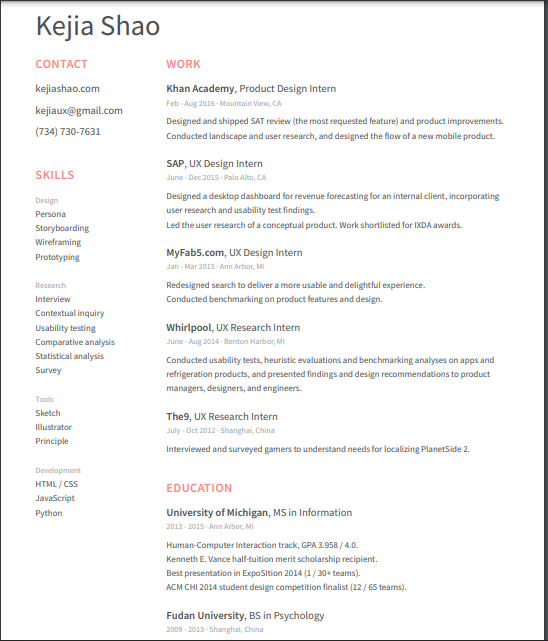
What stands out:
- If you don’t have employment experience, internships are the best way to show your UX design skills. This designer’s resume highlights their expertise and lists their achievements clearly.
- It’s an excellent idea for entry-level designers to use university projects and coursework to their advantage. This resume showcases an outstanding GPA, scholarships, and awards.
Take It Up a Notch:
- When possible, support your achievements with hard metrics and numbers. Instead of “conducted user tests,” a statement like “conducted user testing with a 78% task completion rate” shows the impact of your actions.
Martijn Van Den Broeck

What stands out:
- This resume has a solid design with a clear hierarchy. The designer’s name stands out right away. The eye flows through the experience and education sections, landing on contact information.
- In addition to internships, the designer included other experiences relevant to UX design. Independent projects that use your skills are an excellent way to show your abilities.
Take It Up a Notch:
- Don’t forget the skills section. Your resume should list keywords to pass the application screener and show the recruiter that you are a good fit for the job.
Senior-Level UX Design Resume
If you are an established UX designer advancing your career, take advantage of this opportunity to freshen up your resume. Your visual design skills are no longer enough to differentiate you as a senior designer.
Your real-world experience, people skills, and strategic thinking distinguish you as a senior UX designer.
What To Include
- Show your growth. A history of career growth shows your ambition and commitment. Show a clear progression of your job titles by listing different positions at the same company together.
- Prioritize relevant work experience. In general, it’s best to arrange jobs by reverse date order to help hiring managers understand your career path. But for those changing careers, displaying your most relevant experiences first is more appropriate.
- Highlight leadership skills. Taking on a senior UX role means leading a team, so point out any experience you have managing others. Anything from setting up new projects to leading a committee can show your initiative and leadership skills.
- Think strategically. Leaders must be able to solve organizational issues, master communication challenges, and make critical decisions. Showcase your strategic thinking skills in your resume’s work experience and skills sections.
Ariel Norling
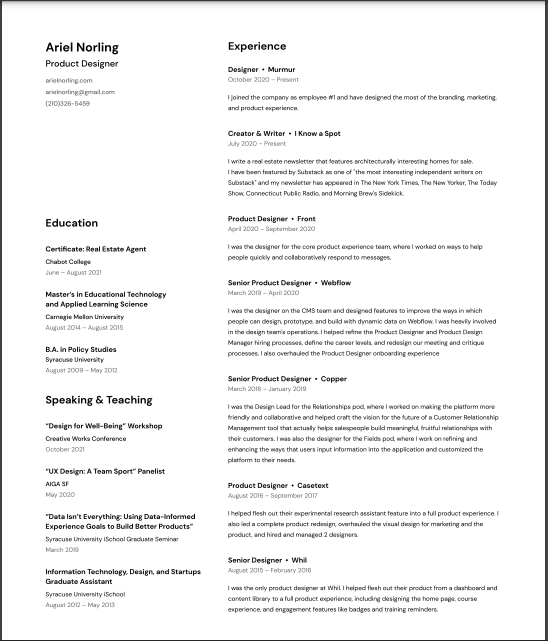
What stands out:
- This designer does a great job of showing career progression. Work experience is in date order and delivers the designer’s growth from student to internship to management. They’ve also included significant achievements at each stage.
- This resume makes the most of usability by logically prioritizing information. The visual hierarchy is well-established. There is an excellent use of whitespace and no unnecessary text or elements.
Take it up a notch:
- Senior-level UX positions have specialized skills. While relevant hard skills are important, don’t overlook the soft skills. Be sure to emphasize your strengths, such as leadership, empathy, and strategic thinking.
Hanna Jung
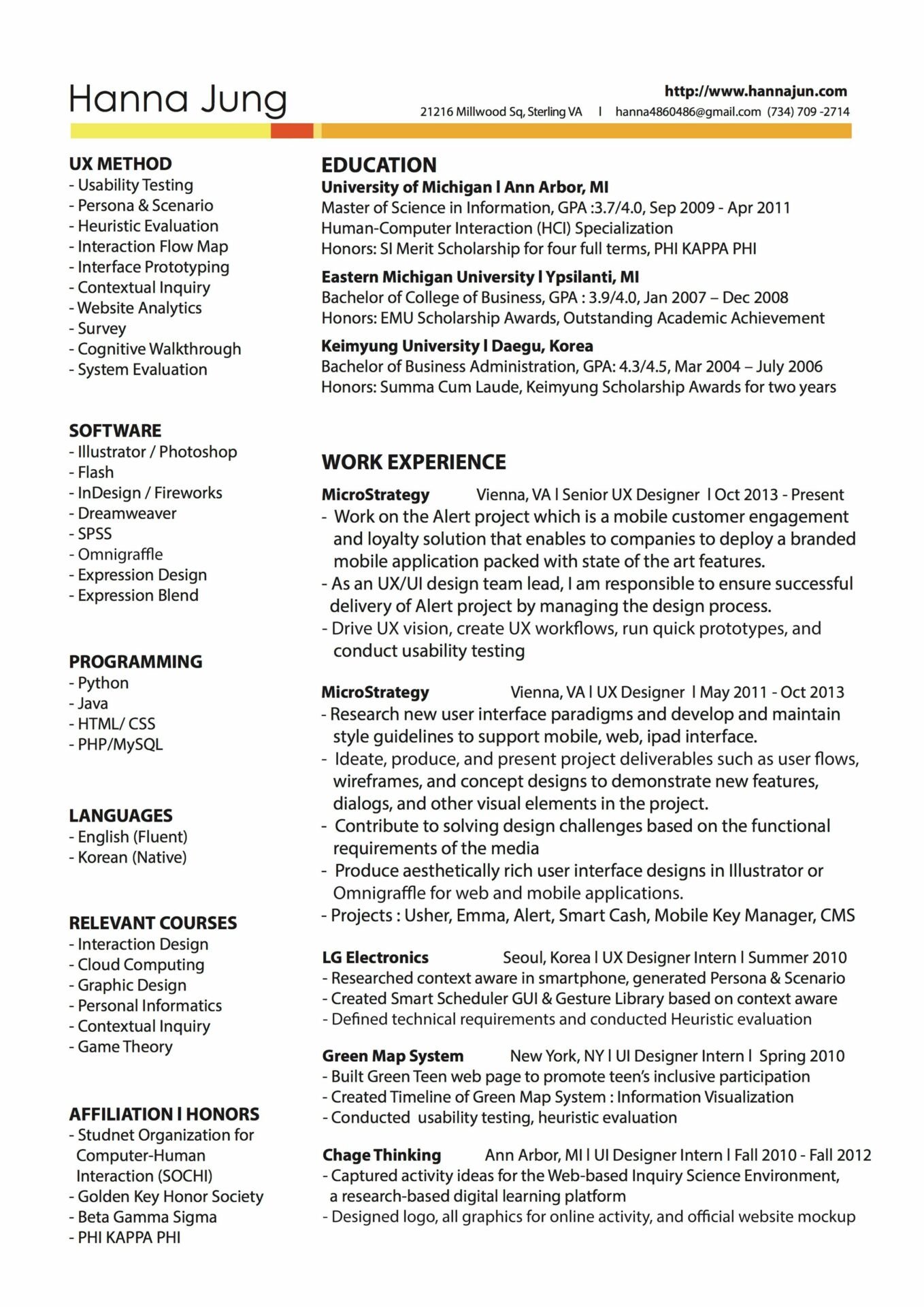
What stands out:
- While a streamlined design is essential, be sure to include as many details as you deem necessary. On one page, this senior UX designer provides a lot of detail. The resume offers several specific examples of relevant accomplishments in each job description.
- The skills section is a great place to showcase your experience with industry-standard tools. This designer includes hard and soft skills relevant to UX, as well as pertinent software and programming.
Take it up a notch:
- Make your resume as simple as possible so that it is easy to scan. Don’t include any visual elements on a resume that is information-heavy. You’ll also have your portfolio to show off your creativity if you want to include a fun design or illustration.
Other UX Designer Resume Examples We Love
Fiona Lin
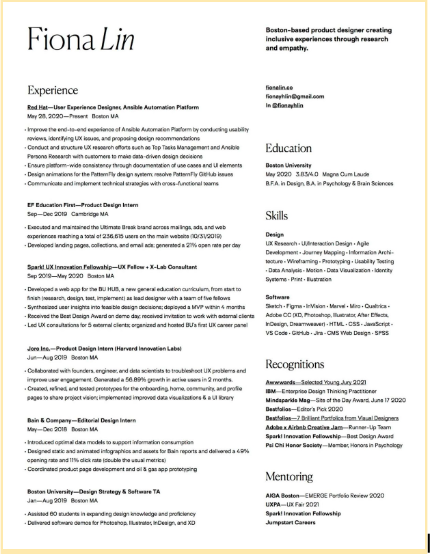
What’s notable: Inject a bit of personality without sacrificing UX by using typography. The well-appointed font pairing on this resume brings attention to each section. The creative use of italics helps place visual emphasis on the designer’s name.
Winona Nasser
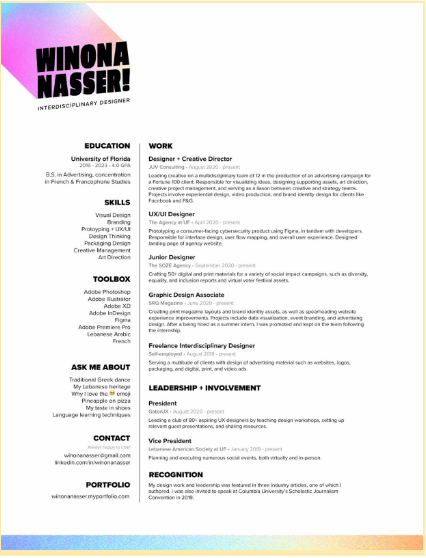
What’s notable: Consider including your non-design-related interests. This designer brought their personality to life with a few fun facts and design elements. This unexpected pop can make you stand out and leave a memorable impression on the hiring manager.
Aaron Brako

What’s notable: This designer went beyond the essentials and included a list of significant projects. The specific contributions and accomplishments reinforce their skills. It also provides hints to what the recruiter will find in their portfolio.
Tips for Creating an Awesome UX Resume
We’ve explored resume design and seen some fantastic examples. Now, let’s put them together and build an impressive UX designer resume.
The following tips will guide you through the design process—and help you avoid common mistakes!
How To Stand Out

- Know your user. Think of your resume as a UX project. Understanding your user will help you design appropriately.
- Optimize your info for your career level. If you’re starting out, highlight your education and notable accomplishments. Focus more on your leadership and your direct impact if you are advancing your career.
- Include relevant keywords. Use keyword phrases from the job description to ensure your resume gets past application filters and ends up in the hands of a recruiter.
- Highlight your key skills. Hiring managers are going to skim most resumes, so make sure your essential skills are noticeable. Show the company that you “speak their language” and are the kind of person they’d like to have as a candidate.
- Think user experience. That’s what you do! Organize your layout so the reader can find what they need quickly. Don’t overcrowd the page or add unnecessary material that gets in the way.
What To Avoid
- Simple errors. The simplest mistakes are the ones that will get your resume thrown out. Double-check for typos, formatting errors, poor grammar, and dead links. Share your draft and incorporate feedback. Making a good first impression is imperative.
- Poor hierarchy or structure. This will reveal much more about you as a designer than any accolades you could list. After all, you are a UX designer. Create a visually appealing, intuitive layout that is easy to navigate.
- Irrelevant details. Be sure to highlight relevant experience and skills based on the job description. A hiring manager can tell if your resume isn’t tailored to the job opening.
- Excessive length. Despite the temptation to fill up your resume with as much information as possible, it’s best to keep it to one page. You can include extra information in your portfolio or website.
- Missing portfolio link. Remember, your resume is just one component of the application. The portfolio is the real deciding factor. Make it easy to find with a prominent link.
Where To Find UX Resume Templates
If you still feel stuck, a template can be a great way to get started.
Many helpful sites offer UX resume templates and advice on content and structure. Here are four of the best places to find UX design resume templates.
1. Coursera

Check out this helpful article on UX resume tips, or go straight to the template PDF download.
2. Uxfolio

Uxfolio claims to have the best UX design template based on research from recruiters and UX professionals.
3. Enhancv
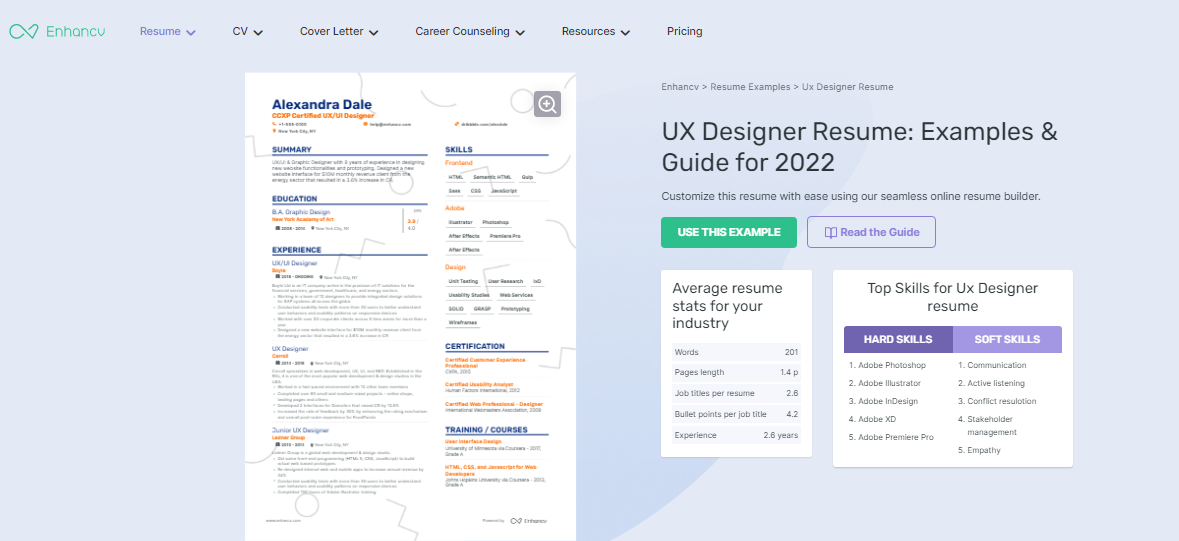
This resume builder site boasts a UX Designer resume “that gets callbacks.”
4. Resume Viking

Here you can find a resume-making guide specific for UX designers, along with several downloadable resume samples.
UX Design Resume FAQs
Still, have questions? We have answers.
Check out these commonly-asked questions about UX designer resumes.
Should You Customize Your Design CV for Each Job?
Yes. You should customize every resume for the position you are applying for.
This doesn’t mean you need to rewrite your resume for each job. Simply tweak it a bit to make it job-specific.
Review the job description and highlight the critical requirements. If you have those skills, be sure to list them using the exact words written in the job post.
This will show the company that you understand their needs and are the kind of candidate they are looking for.
How Long Should a Design Resume Be?
A single page. Nothing more.
Delete those irrelevant positions from ages ago and remove all that fancy language from your job descriptions. The best resumes are concise and clean, easy to read at a glance, and aren’t overwhelming for the reader.
Provide links to your personal portfolio website or LinkedIn profile if you want to provide more information.
What Skills Should You Put On Your UX Design Resume?
This depends on the position.
To decide which skills to include on your resume, examine the job description and reference the listed skills.
UX designer skills can cover everything from graphic design to psychology to Javascript. Some of the most critical skills UX designers need are:
- research
- information architecture
- wireframing and prototyping
- visual design
- UX writing
- strategic and decision thinking
- communication and collaboration
- user empathy
Land Your Dream UX Designer Job With a Solid Resume

The same skills that make you a great UX designer can help you create a killer resume.
Approaching your resume as though it were a UX design project will set you up for success.
Designing a resume can be challenging, but it’s also an excellent opportunity. Take this time to reflect on your accomplishments and set goals for the future.
Taking a Springboard course is a great way to add a new bullet point to your resume and improve your UX design skills. Learn at your pace with 1-on-1 mentorship and career coaching from industry experts.
With an immersive UX Bootcamp that prepares you for employment within six months, you’ll have a fresh resume in no time.
Since you’re here…
Interested in a career in UX design? Rise to the top of the CV pile when you enroll in our UX Bootcamp—you’ll get a UX job or your tuition money back. Take a look at our student reviews and test out our free UX curriculum to get a feel for our style and results. TL;DR: average starting salaries for our students = $85,440. Let’s do this.



![8 Best UX Design Courses for Beginners [2022 Guide]](https://www.springboard.com/blog/wp-content/uploads/2022/08/ux-design-best-courses-380x235.png)

